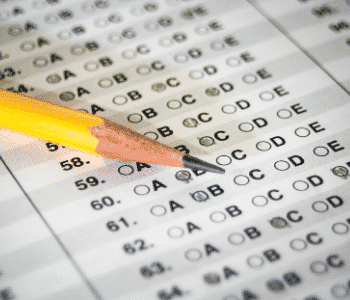Fixing Academic Cheating in the Age of Coronavirus
The pandemic is forcing us to rethink assessment.

Judging from the news coverage, there doesn’t seem to be much doubt about it: As schools were forced to move online due to the Coronavirus epidemic, academic integrity became a much larger problem.
In Canada, a recent article by Giacomo Panico at the CBC interviewed Elaine Eaton, an assistant professor at the University of Calgary, who said, “I am hearing from colleagues not only across the country but across the world that academic misconduct has surged during the winter 2020 term, due in part to the remote pivot to online learning during the pandemic.”
In South Korea, some 90 med school students at the Inha University’s School of Medicine were caught cheating, making up 83% of the school’s freshman and sophomore class. The school is now requiring such exams be held in person, despite concerns over the virus.
Meanwhile, back in the United States, the Advanced Placement (AP) exams were fraught will allegations of cheating, including the use of Discord servers to share answers. All of this in spite of efforts by the College Board to clamp down on cheating and revise their policies around security.
At the same time, academic integrity issues are on the rise, there’s also a stern backlash against tools that aim to stop it. As the CBC article pointed out, there is significant pushback against the use of webcams in virtual classrooms over privacy concerns. Proctorio, a popular service that uses artificial intelligence to attempt to detect cheating, has been heavily criticized for everything from technical issues to concerns over potential racial bias.
While it’s easy to blame these issues on the sudden way many schools had to make the jump from in-person to distance learning, they’ve actually been issues in distance learning for some time. Back in October, well before the Coronavirus pandemic, a survey of some 1,967 faculty members found that 60% believe that academic fraud is more common in online courses.
Whether that appearance is shown in the data remains to be seen. Studies on cheating in online education have come up with conflicting results with some finding it increases cheating while others find that online students are actually less likely to cheat.
Either way, there is definitely the perception of a problem and that is should be enough to have schools and instructors look at ways they can address online cheating, especially as it is increasingly becoming part of the “new normal” in education.
The Root of the Problem

The basis of the problem is straightforward: Assignment types that work reasonably well in an in-person environment easy to circumvent when doing distance learning.
For example, short answer and multiple-choice answers are relatively difficult to cheat on in an in-person classroom. Though students can and do cheat on such tests, without advanced knowledge of the questions, cheating requires students to take action in the classroom which could easily get them caught. The risk/reward ratio isn’t worth it for most students.
However, everything changes when testing moves online. Students can easily pass such answers back and forth through text messages, Discord chats or other means. Cheating becomes easier, the risk of getting caught becomes lower and the punishment if caught remains relatively the same.
To be clear, there are steps that can make cheating more difficult, such as having multiple versions of the test, making tests timed and mixing different types of test questions. However, as the AP tests showed, students can find ways to circumvent those as well if they are motivated or pressured enough to do so.
The ways we test students were already showing their cracks before the current pandemic and the current climate appears to have strained them to the breaking point.
Sadly, there are no easy answers here, just challenges that many schools seem ill-equipped to face.
Addressing the Problem
There are no easy answers here. As Eaton said in the CBC article:
“Expecting students not to do that is quite unrealistic because we know that students are also under pressure to perform and in some cases, if the kind of assessment you’re giving them tempts them into unethical behavior, then they may make poor decisions.”
Simply put, online education does not and cannot mean that you take what you were doing in the physical classroom and simply transport it to the internet. This applies to all aspects of education but is especially true for assessment.
The only way to actually address this issue to fundamentally reevaluate how assessment is going to work online. This is going to mean examining some very fundamental questions about the very nature of education including:
- What are we trying to teach students?
- What are the most important items for them to learn?
- How do we assess whether they’ve learned that?
- How do we make assessment part of the teaching process?
- How do we make students engaged and interested in assessment?
These are all difficult questions and doubly so in places such as the United States, which has a heavy reliance on standardized testing. When students and teachers alike are used to targeting multiple-choice tests, it can be jarring to realize those kinds of tests may not be tenable.
Interestingly, one of the assignments where schools are better prepared are essay assignments. Schools have decades of experience with those being written at home where students have access to the internet. Not only do we have software that can detect plagiarism and collusion, but we have practices in place that can discourage plagiarism, such as crafting plagiarism-resistant assignments.
Many of those same lessons can be reapplied. For example, teachers can make short answer questions more personal in nature, offer non-traditional assignments such as creating websites or videos and require students to show their work completely as a means to reduce cheating.
That said, essays have a lot of drawbacks for assessment including the time it takes to grade them, the potential for biases and the fact many students simply aren’t very good at them. Any good assessment strategy will mean a variety of assessment tools, but it will likely mean a different set of tools than what most use now.
This is an area where change is inevitable. The only question is how far behind our classrooms will fall before starting to catch back up?
Bottom Line
Though Coronavirus brought this particular issue to a head, the truth is that online education has been a growing presence for more than a decade and the trend to more online learning was inescapable well before the pandemic.
Ultimately, the benefits of online learning far outweigh the drawbacks. Still, that doesn’t mean we give up and accept those drawbacks as an inescapable fact of life. Many of them can be mitigated and even eliminated.
However, to do that we have to be willing to rethink education and assessment more broadly. This isn’t just a matter of adapting in-person practices for an online world, it’s becoming increasingly clear there needs to be a fundamental rethinking about education.
Unfortunately, such a fundamental rethinking has been a long time coming. Though the current pandemic may be highlighting the current issues, they’ve always been there.
To fix education, we may have to reinvent much of it. It’s a lot of work but, if we do it, both students and instructors will be far better off for it.
Want to Reuse or Republish this Content?
If you want to feature this article in your site, classroom or elsewhere, just let us know! We usually grant permission within 24 hours.
